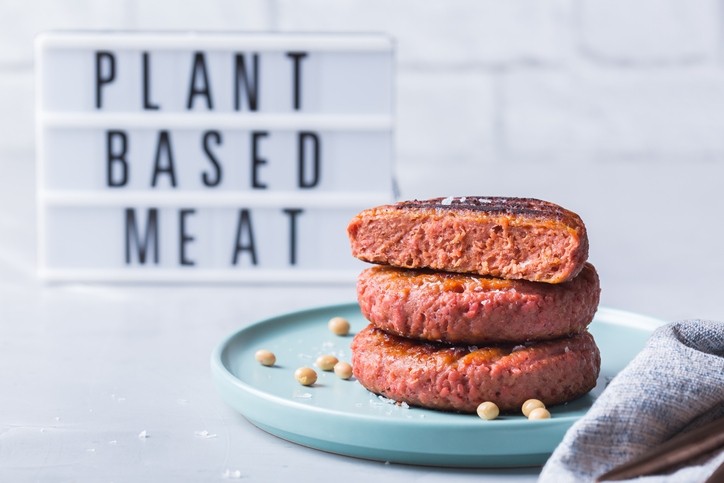Improving taste, texture and overly long ingredient lists remain key to growth in the plant-based meat alternative segment, Protein Vision hears

According the consultancy New Nutrition Business, most European markets are still growing somewhat with Germany, UK, Netherlands and Sweden in front. Southern European markets are smaller and growing slower.
The UK grew 15% to £607 million in 2021 which may be the highest growth rate in Europe and the UK is jointly the biggest market with Germany. But overall meat-free is struggling to break 2% market share of the protein market everywhere (owing to under-performance on taste, texture and overly long ingredient lists).
The consultancy says the true scale of this market opportunity is 'big niche' at best, because plant-based meat substitutes clash badly with food culture and under-perform on consumer expectations.
But there’s a huge amount of growth opportunity, speakers told FoodNavigator’s Protein Vision event, which is available to watch on demand here.
“This is still a young and nascent industry that has witnessed high double0digit growth in the last few years investment has been steadily growing,” said Albrecht Wolfmeyer, who heads the ProVeg Incubator, the world’s leading accelerator programme for plant-based food start-ups. “Now we’re seeing a bit of a downward the pace is slowing down a little bit which doesn’t mean this is fatigue of the end of the success story. We also have to look at different geographies, products and companies – to get a bigger picture of the market. In Germany we have seen growth of more than 30% in the category in 2021.”
“There are so many reasons to come into this category… health, sustainability, animal welfare that we will eventually talk to everyone ,” said Nathalie Denno, Chief Marketing & Communication Officer at French start-up Umiami. “It’s just a matter of time and having enough key players that choose an angle that is clear for people.”
Umiami’s angle for instance is proprietary high moisture technology that it claims can better replicate whole meat cuts. The vast majority of the real meat market for instance is made up of whole meat cuts. Nailing this sector is therefore seen as key for the market to gain repeat purchases. “The process also enables us to improve the nutritional profile of meat replacements as no texturizing agents are needed,” Denno added.
Mark Stavro, Senior Director of Global Marketing & Product Management at Bunge agreed there’s a huge amount of growth opportunity. “As we start to innovate on creating more and more food applications and opportunities for consumers to eat these alternative meat products and as we start to enhance the taste and texture further you’ll start to see more growth in the category. Cracking all that code is key,” he said.
“As you start to see improvements in taste, texture, reducing in pricing you start to create more and more meat like products across breakfast, snacks, lunch and dinner throughout the day, every day.”
He added that newer proteins such as fava, lentil, mung and canola are coming to the market to compliment soy and pea. “What we’re finding is that a lot of these different proteins have very different functionalities: some are soluble, some are great for gelling. So what you can do is mix and match them to make different applications.”
Bunge is also combining newer proteins with its oils and fats range. “Most meats are a protein and fat matrix so we’re doing a lot of work trying to recreate those matrixes across a host of applications to get closer to the real authentic meat experience.”
Jaume Cirera, Market Segment Manager for Alternative Protein at Griffith Foods, also called for a greater range of product offering. “If we want more consumers to start and stay in the meat-reduction journey, we need to offer as many alternatives to their current animal products as possible. Plant-based fish, furthermore, carries a strong marine conservation message.
"In fact, from our research, we see the lack of variety as one of the main barriers why some consumers are not yet being into plant-based products, even though they would like to reduce their meat intake.
"As with most products, I think the industry needs to listen to consumers and try to understand their drivers and their barriers for purchase. If we support the growing number of consumers that venture into the meat reduction journey with the right levers, we'll be able to maintain the excitement.
"We've seen that this initial excitement has come from plant-based brands sending very clear messages on the benefit in terms of the drivers, which are mainly health, sustainability and animal welfare. That has definitely contributed to the recent plant-based boom. However, the repurchase effect that is needed for maintained excitement is also affected by the most important barriers, namely taste, texture, price and the friendliness of the ingredient declarations.
"And it is in these areas where we see the biggest room for improvement. Brands really need to offer products that provide the eating experience of animal meat, for a reasonable price, and with a recognizable list of ingredients. These are our areas of focus at Griffith Foods, and I feel that once we hit these milestones, the potential growth rates of the segment will not be put in question anymore.”
Wolfmeyer added there are good reasons to be excited about fungi-based products and fermented products that will add a new way of providing whole cut meat analogues and seafood alternatives at some point. “They provide so many things by nature such as structure and fibrousness that consumers expect,” he said. “It’s early stages but we will see more of these products in future and there is a need to invest in the infrastructure to make this possible, it will be game changer.”
Meanwhile, do people want better mimicry or newer experiences in this category?
“We’re still at the early adoption stage so mimicry is still really important, and consumers are right in saying many products aren’t as good as they should be so taste is an issues,” said Wolfmeyer.
“There is at the same time a need for innovative products that will have innovative names that will provide different experiences so I think we will see both in parallel and hopefully we’ll see more of the novel products that are not just mimicking but at the moment that’s necessary.
“They need to catch up on taste, texture and functionality and then we can be excited about the next generation of meat alternatives.”
Denno added: “We see that people are willing to move to plant based but are not willing to change their habits too fast. If we can mimic, then people can cook what they’re used to. But at the same time, we are working on products for the mid-term that will have their own identity – but that’s a second step.”

























